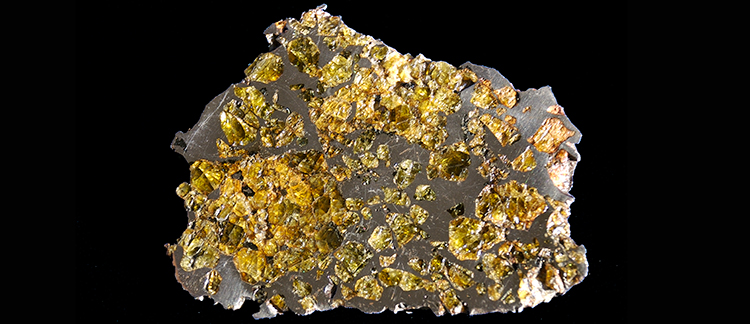Meteorite

A meteorite is a stony or metallic piece of meteor that reached Earth's surface. Meteorites have been found all over the world, and of the 1,671 verified in the United States as of April 2013, 158 came from Kansas (see Meteorites in the United States).
Meteorites are classified into three main types:
- Stones—composed primarily of silicate minerals (compounds consisting of silicon, oxygen, and various metallic elements); similar to rocks found on Earth.
- Irons—made primarily of iron and nickel in varying proportions.
- Stony-irons—composed of both silicates and metals in approximately equal proportions.
Within these three main categories, meteorites are further subdivided into a number of classes. Meteorites found in Kansas include representative samples of most of the various types of meteorites.
Western Kansas is a good place to find meteorites because the wide-open country has few trees and terrestrial rocks at the surface and most of the region is heavily cultivated but not otherwise extensively developed. Thus, anything out of the ordinary stands out. In addition, western Kansas is semiarid, so meteorites disintegrate more slowly there than in wetter regions.
In 1882, Eliza Kimberly discovered what would become one of the most spectacular meteorite finds in Kansas on her family's property near the town of Brenham in Kiowa County. The rocks she collected piqued the interest of scientists and meteorite hunters, who have since collected many more. All of the samples are believed to be from one meteorite that broke up on its way down. Over the years, more than three tons of debris from the Brenham Meteorite have been found at the site, including the largest example found in Kansas. In 2005, a 1,400-pound piece was located with a specially designed metal detector. This specimen is an oriented pallasite, a stony-iron body that remained oriented in one position as it fell so that the lead side taking the brunt of the atmospheric heat was sculpted into a rounded or conical shape. Only two larger meteorites of that type have been verified in the world.
Resources
Buchanan, R., 2010, Kansas Geology: An Introduction to Landscapes, Rocks, Minerals, and Fossils (2nd ed.): Lawrence, Kansas, University Press of Kansas, 240 p.
Buchanan, R., and McCauley, J. R., 2010, Roadside Kansas: A Traveler's Guide to Its Geology and Landmarks (2nd ed.): Lawrence, Kansas, University Press of Kansas, 392 p.
Suchy, D. R., 2007, Meteorites in Kansas: Kansas Geological Survey, Public Information Circular 26.
Kansas Rocks and Minerals, Kansas Geological Survey Educational Series 2